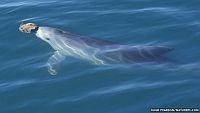
Sponger photo: Hugh Pearson/Naturepl.com
While it was long thought that only humans made and used tools, we now know that a variety of apes and monkeys are toolmakers. Elephants, crows, sea otters and octopus have also been observed making tools. Now, we can add dolphins to the list.
Recently, scientists discovered Indo-Pacific bottlenose dolphins in Shark Bay off the coast of Australia apparently use tools. They carry sponges on their snouts which may help protect their sensitive beaks from sharp rocks and other hazards as they probe the seafloor for food. Scientists report that more than 60 percent of all female dolphins practice sponging, and up to half of all males born to “spongers” in one part of the bay grow up to become spongers themselves. The scientists also discovered that the sponger and non-sponger dolphins had dramatically different diets. The sponging dolphins apparently have access to different foods than the non-spongers.
Dolphins Put Sponges on Snouts to Snag Elusive Snacks
The researchers suggest that spongers may feed on fish that live near the seafloor, ones lacking organs known as swim bladders that help fish stay buoyant in the water. These bottom-dwelling fish are difficult to spot using the echolocation, or biological sonar, that dolphins normally use to pinpoint prey — the complex surface of the seafloor can muddy a dolphin’s echolocation. …
In future studies, the scientists would also like to discover what benefits accrue from another tool-use strategy, known as shelling, that dolphins in Shark Bay practice; with shelling, dolphins carry seashells around in their mouths.
